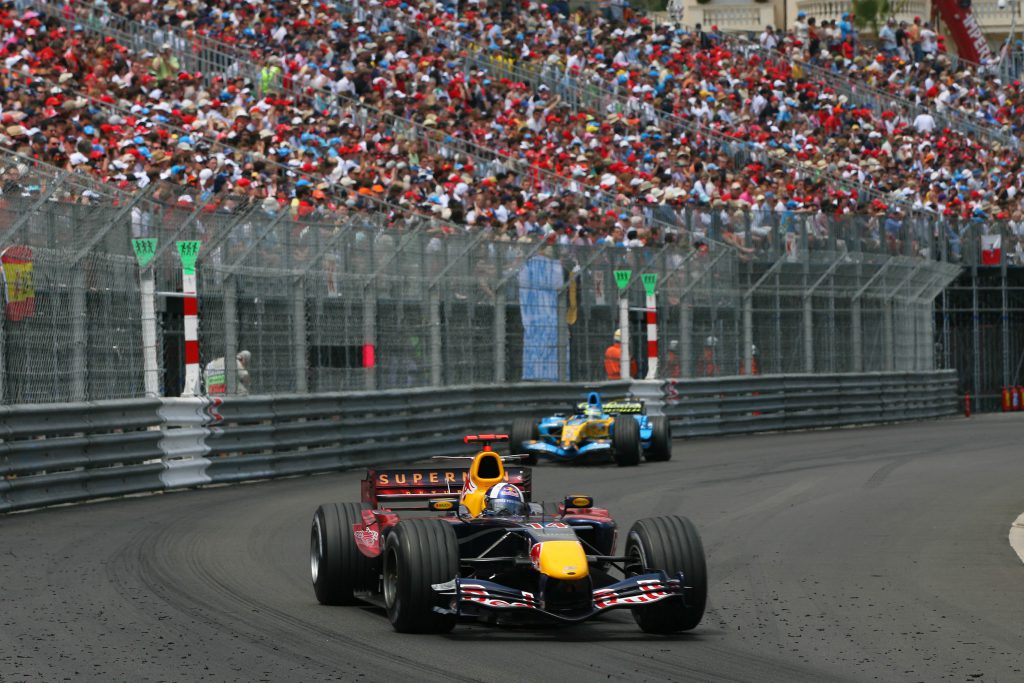Up Next

When Red Bull took over the ownership of the team previously known as Jaguar for the 2005 season, few would have predicted 300 races, 63 wins and four constructors’ titles.
From its humble beginnings with David Coulthard and Christian Klien through the four world championship drivers’ and constructors’ doubles from 2010-2013, right up to the emergence of Max Verstappen and its Honda switch, the team has always offered excitement.
Our writers have scoured the history books to deliver the highlights of Red Bull’s F1 stay, including ones it will want to remember for ever, and others it would give anything to forget.
Best moments: Maiden glory – China 2009
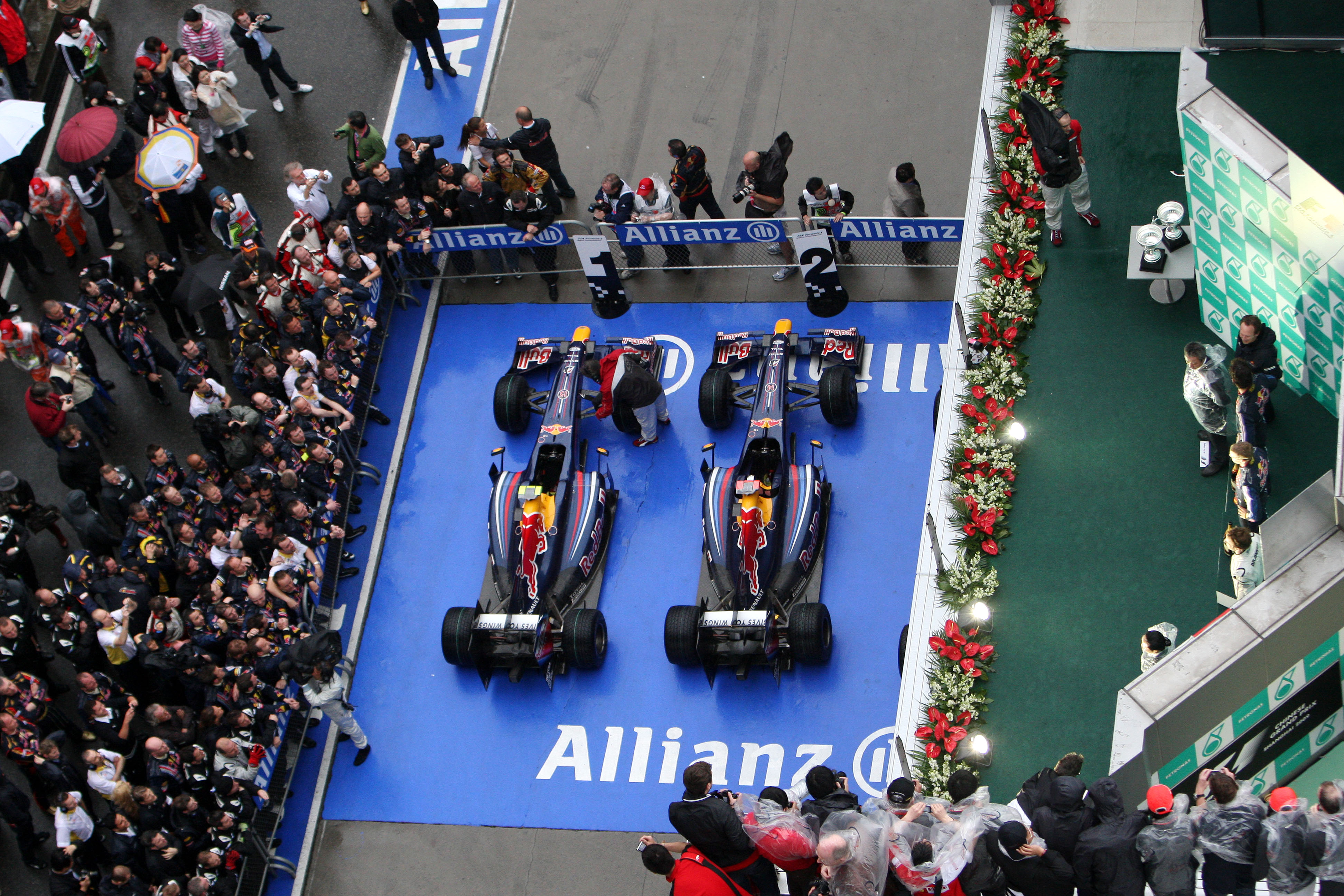
The team’s first win, China 2009. The all-new aerodynamic regulations of this season swept in a new competitive order as each of the previously dominant teams, McLaren and Ferrari, got the concept of their cars all wrong.
What made it even more exciting were the identity of the two teams who’d got it right – the newly-labelled back-from-brink Brawn and the noisy neighbour newcomer Red Bull. Neither had much of a pedigree and yet suddenly they were the class of the field.
Brawn, on the tightest of budgets, had won the opening two races with its double diffuser masterpiece. Red Bull had missed the double diffuser trick, yet was the Brawn’s closer challenger, and that RB5 design would prove to be the template for all F1 cars of the following years.
It was very gratifying that Jenson Button, after staring at the possible end of his career without having made good on his great potential, was finally in a competitive F1 car in his 10th season. But what was equally exciting were the prospects of the two Red Bull drivers Sebastian Vettel and Mark Webber.
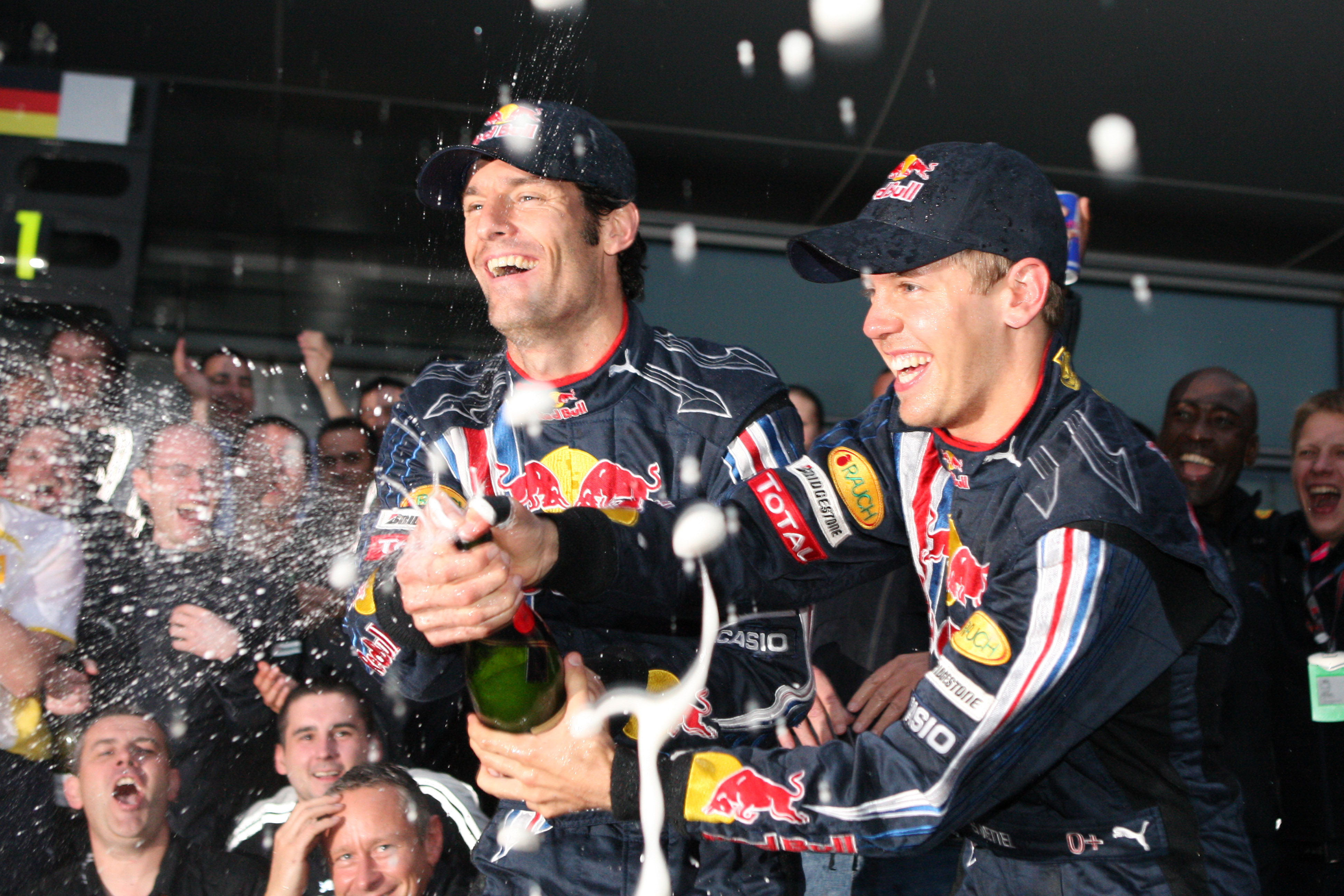
Vettel’s startling victory for Toro Rosso a few months earlier marked him out as a superstar in waiting and his arrival in the senior team could not have been more perfectly timed. You had to be concerned for Webber who, like Button, had shown occasional searing pace in second rate cars for years.
But now, just as the great car had arrived, he was paired with this young sensation. Worse than that, he’d suffered multiple broken bones in an off-season cycling accident. Never a good time to do that, of course, but this was among the worst imaginable.
The suddenly-transformed prospects of these three (Rubens Barrichello in the second Brawn had already tasted plenty of success in a good car with Ferrari) was definitely a very welcome element. The excitement of the new.
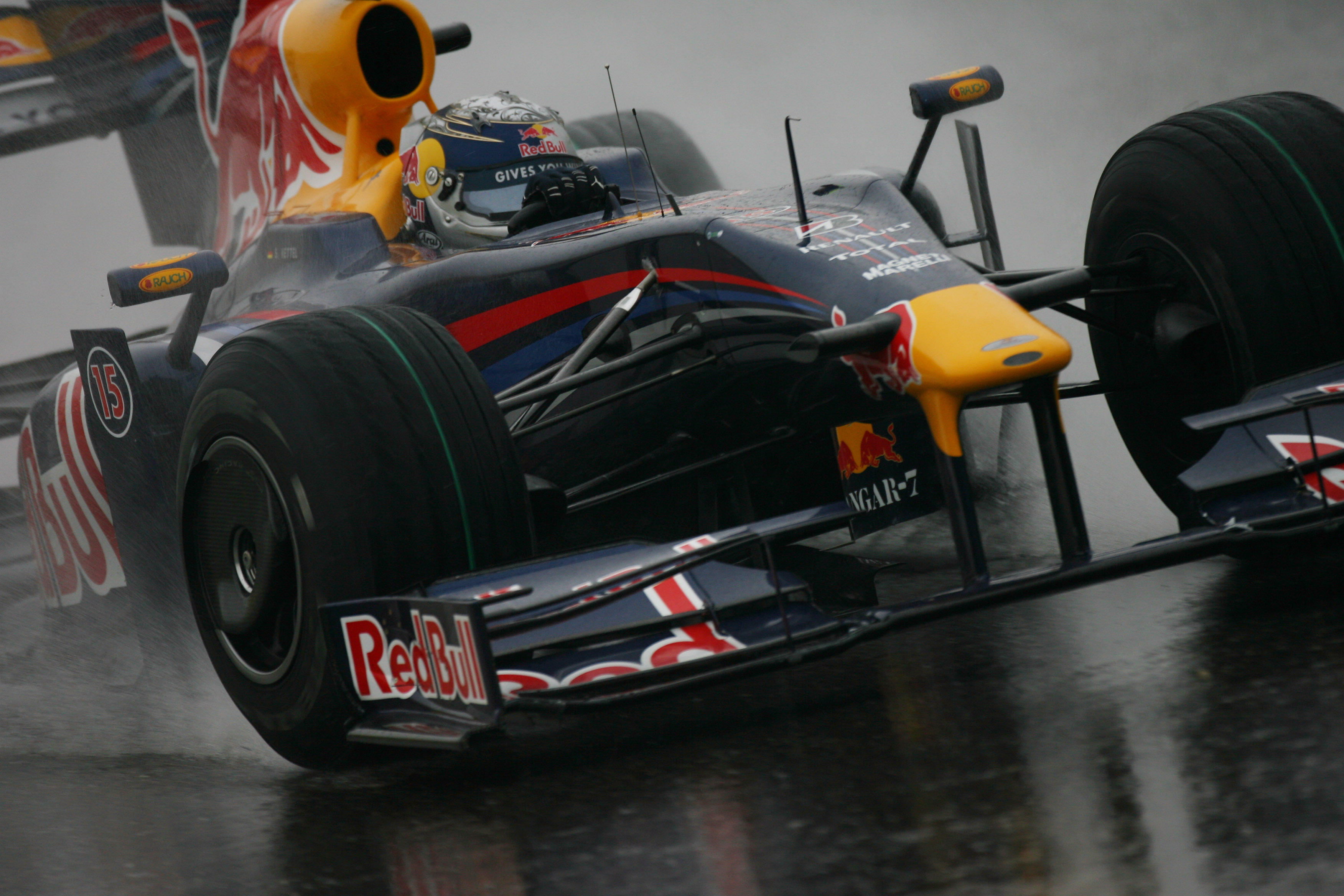
The Red Bull breakthrough came at Shanghai, the third race of the season. A leak was discovered on Vettel’s driveshaft on the eve of qualifying – and there was no time to fix it. It meant he could do only one flying lap at a time before coming in to have the driveshaft repacked with grease. So every lap had to count. Remarkably, he went fastest in Q1, Q2 and Q3, with just one lap in each case.
Then he dominated the wet race, which confirmed his burgeoning mega credentials. He’d won already with Toro Rosso, of course. But giving the senior team its maiden win was massive – and made all the sweeter by Webber’s second place, ahead of Button.
Webber must have had very mixed feelings – but he didn’t let them show as he joined the huge team celebrations in the paddock. He probably figured his day was coming.
–Mark Hughes
Worst moments: Multi 21 – Malaysia 2013
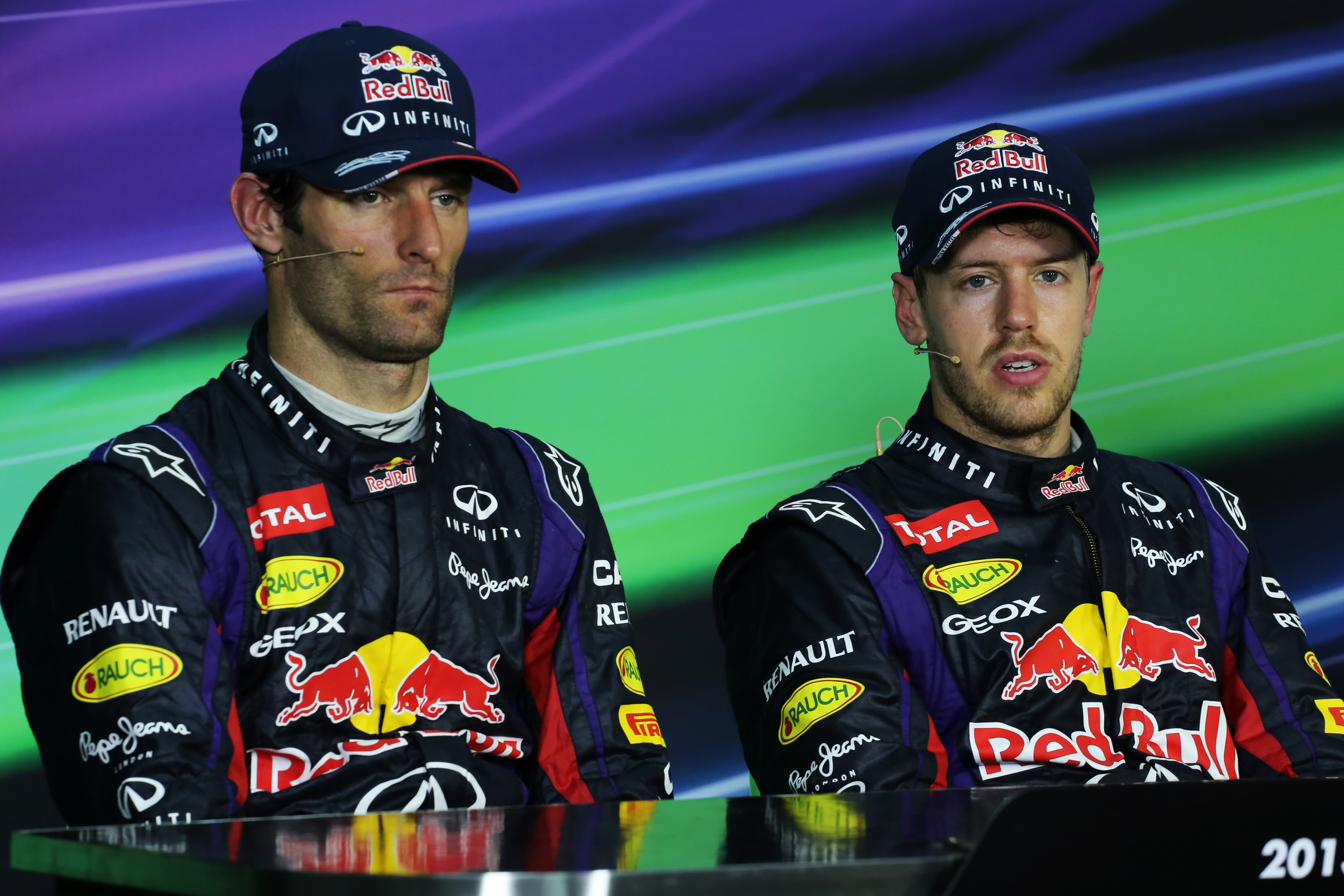
The 2013 Malaysian Grand Prix and the infamous Multi 21 incident confirmed that the Vettel-Webber partnership had probably run its course.
Although there was no on-track incident this time, Vettel broke team orders to pass his team-mate for the win, causing their previous competitive tolerance of each other to break down. A yet-more tense environment than previously pervaded the team for the rest of the year, even after Webber’s mid-season announcement that he would be retiring from F1 at the end of the year.
Webber had taken the lead from Vettel by running a longer first stint and jumping ahead on a damp track. But Vettel had got himself onto Webber’s tail going into the final stint and insisted he was quicker.
Awkward 😬
Red Bull's 'Multi 21' controversy happened #OnThisDay in 2013#F1 pic.twitter.com/gndhi911cu
— Formula 1 (@F1) March 24, 2020
The team’s Multi 21 (Webber, race number 2 ahead of Vettel race number 1) call confirmed he should hold position. But Webber – as at Turkey 2010 – seemed to be backing Vettel up, making him vulnerable to the chasing McLaren.
The backdrop to the incident went back to the opening lap of the 2012 title-decider (more on that below) between Vettel and Fernando Alonso at the Brazilian Grand Prix when Webber – who was not in contention for the title – had squeezed Vettel up against the pitwall off the start, costing him places and contributing to Vettel’s incident at Turn 4 in which he made contact with Bruno Senna and spun.
Vettel remained understandably irritated at Webber’s actions and, according to team boss Christian Horner, later confirmed to Webber that’s why he ignored the Multi 21 instruction.
– Mark Hughes
Best: Honda success – Austria 2019
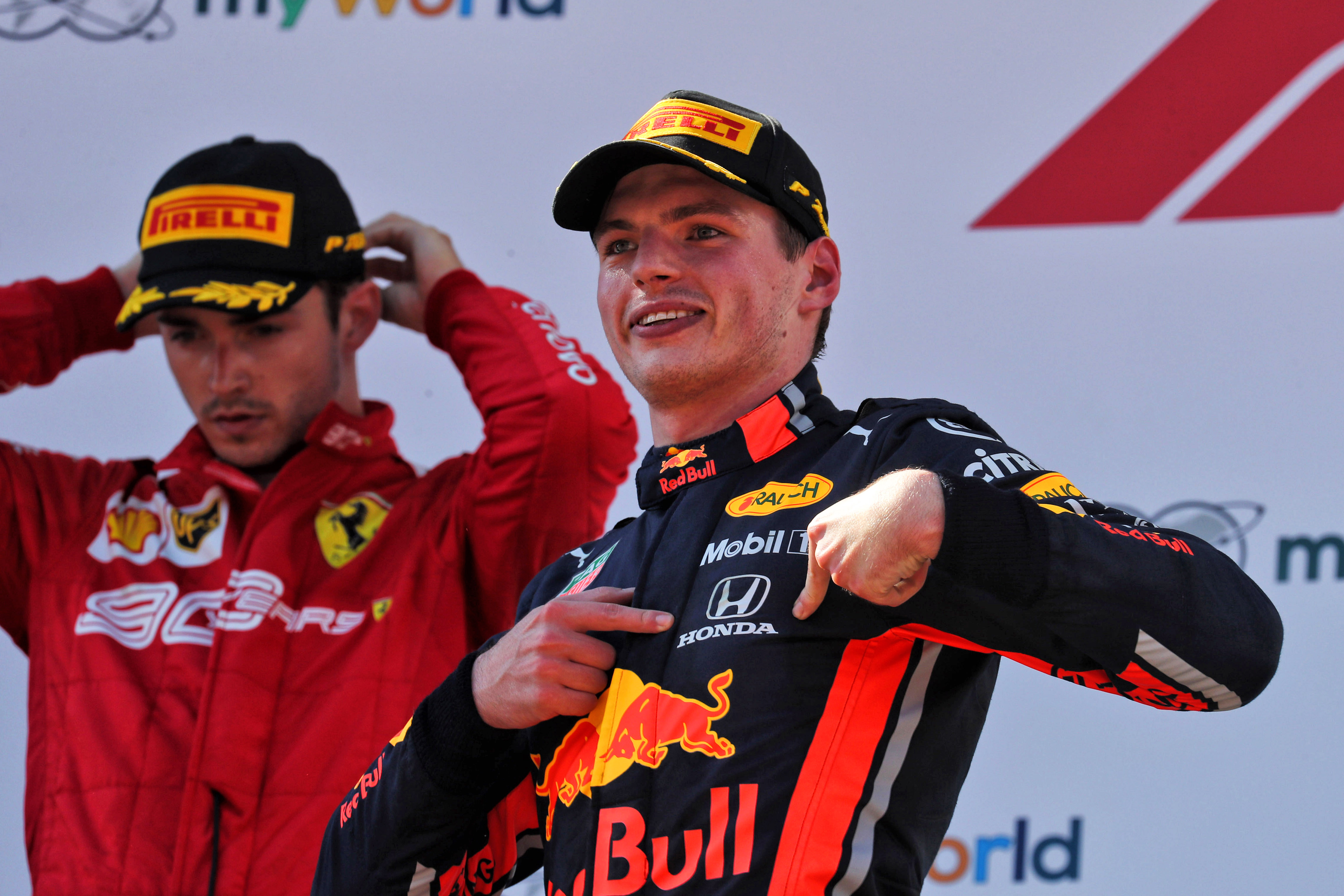
I’m allowing for a small amount of sentimentality to creep in and influence this pick. Because I know how much effort and commitment went into turning around the Honda project and what an emotional release the first victory was.
Honda’s F1 project was almost on its knees in 2017 following its McLaren tenure and leaving in disgrace and embarrassment was an option.
Red Bull took the plunge and backed Honda to continue and OK, that first win has been a false dawn in terms of leading to the expected championship challenge, but as a standalone moment few in recent memory can match it for emotional intensity.
This might sound like it’s a Honda moment, really, but it isn’t. It’s a shared success. Red Bull threw everything at Honda and Verstappen stuck a very strong chord with the Japanese.
Then the honeymoon period was relatively shortlived on-track as a debut Red Bull-Honda podium in Australia gave way to some lacklustre results.
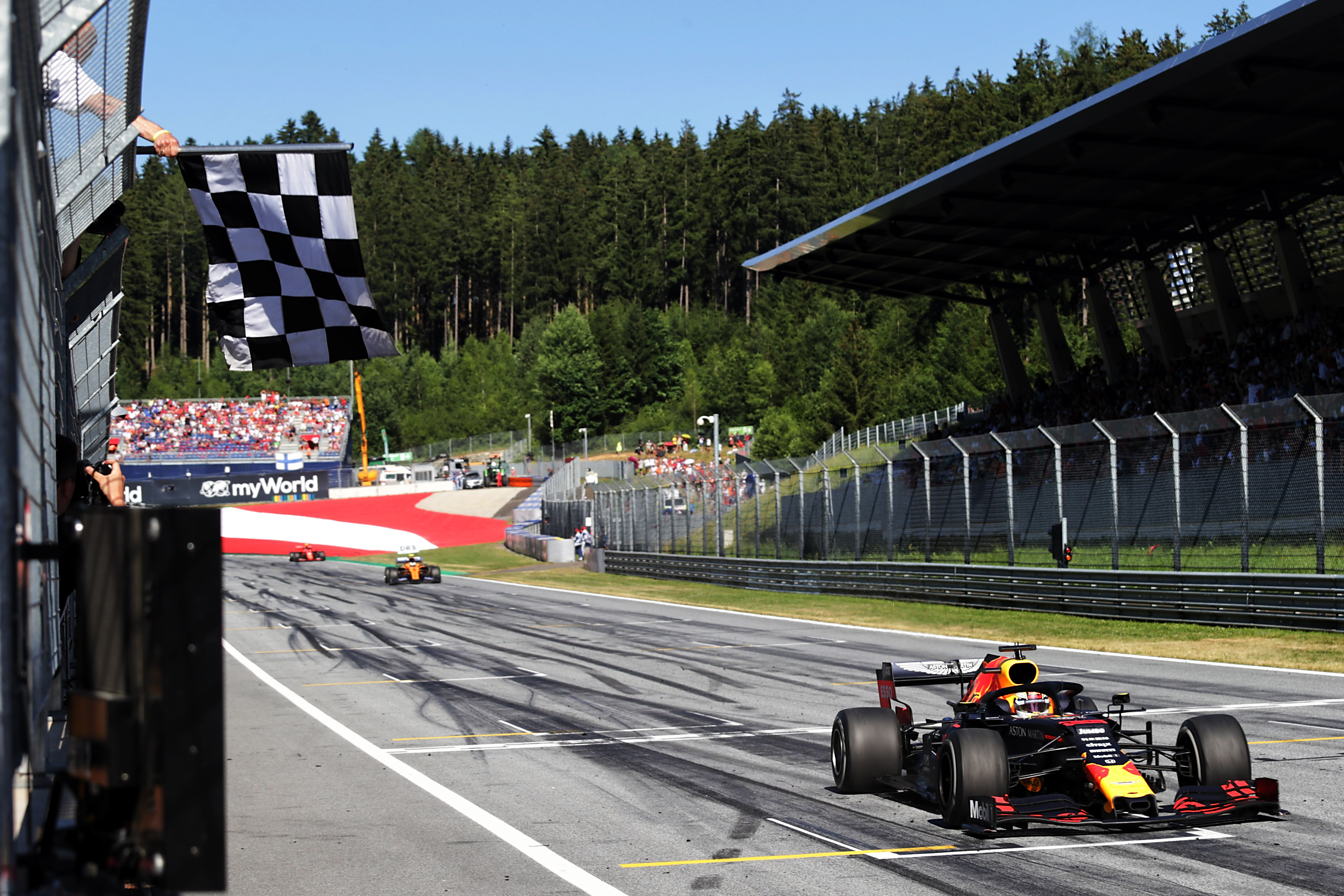
But how could it have gone any better that one weekend in Austria? Red Bull’s home race, Honda executives on-site, Verstappen hunting down Charles Leclerc’s Ferrari after a terrible start and race-long recovery…and a stunning, aggressive, dramatic pass to steal the win.
You can’t cheer for a certain outcome as a neutral. But when they happen, affording a smile’s not the end of the world. Red Bull made Honda a winner again and that will stand the test of time as a wonderful achievement – especially the manner in which it was earned.
– Scott Mitchell
Worst: Crashing team-mates, chapter 1 – Turkey 2010
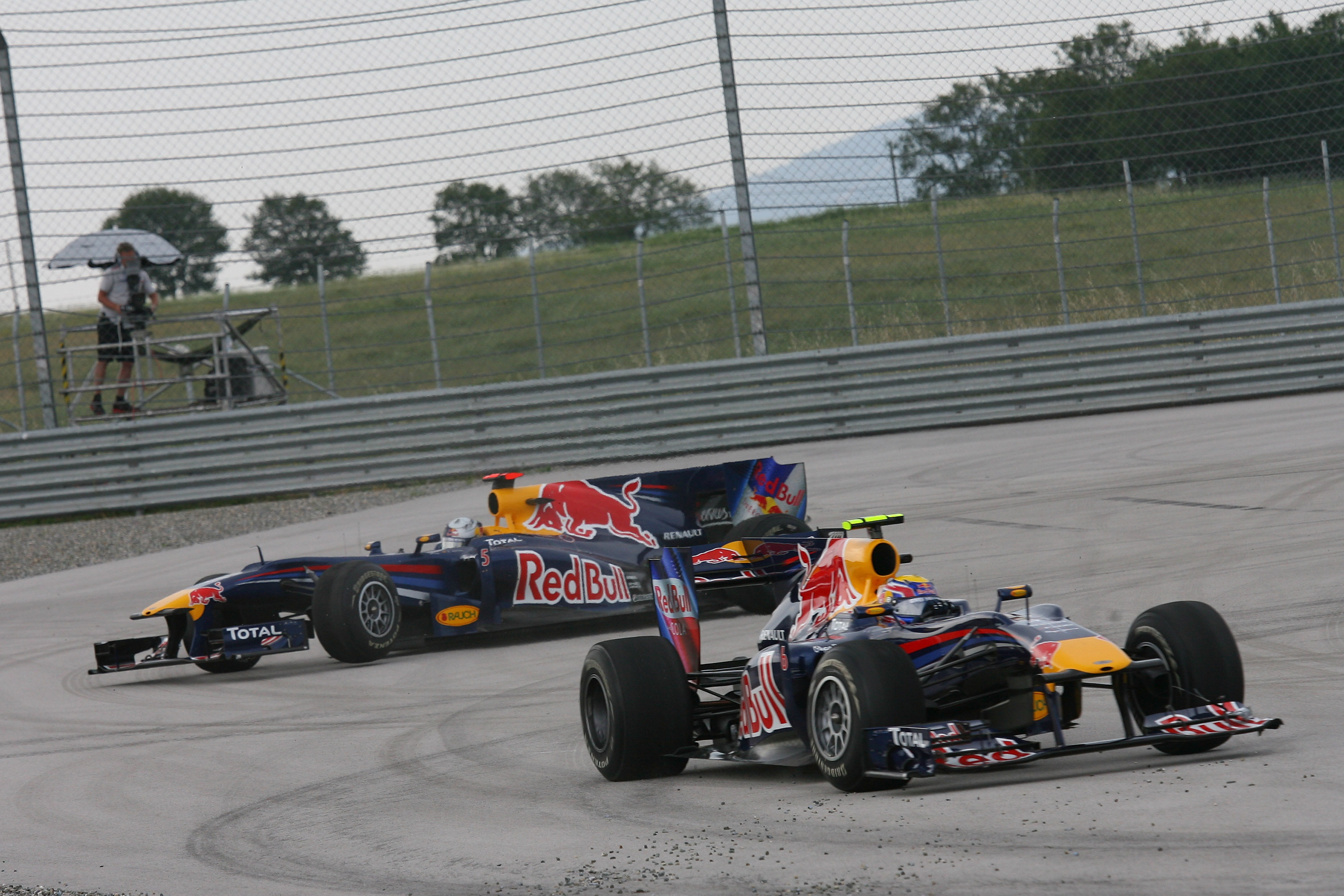
Team-mates colliding while battling for the lead of a grand prix – what’s not to love?
But it wasn’t the incident that goes down as a particularly black mark in Red Bull’s F1 history. It was the way it was handled afterwards.
The team’s reluctance to take Vettel to task – even privately – for being at fault for the incident (which he was) gave the first clear indications of a couple of things: firstly, Red Bull’s reluctance to manage its star driver with a firm hand, and secondly, the doubts it raised over who was really calling the shots between Christian Horner and Helmut Marko.
Sure, Webber fanned the flames from time-to-time, but the mishandling of the Turkey 2010 fall out led to many of the episodes that followed, from “not bad for a number two driver” to Multi 21.
Red Bull would be entitled to argue, of course, that four world championships in a row with Vettel suggest it handled things just fine.
– Glenn Freeman
Worst: Crashing team-mates, chapter 2 – Baku 2018
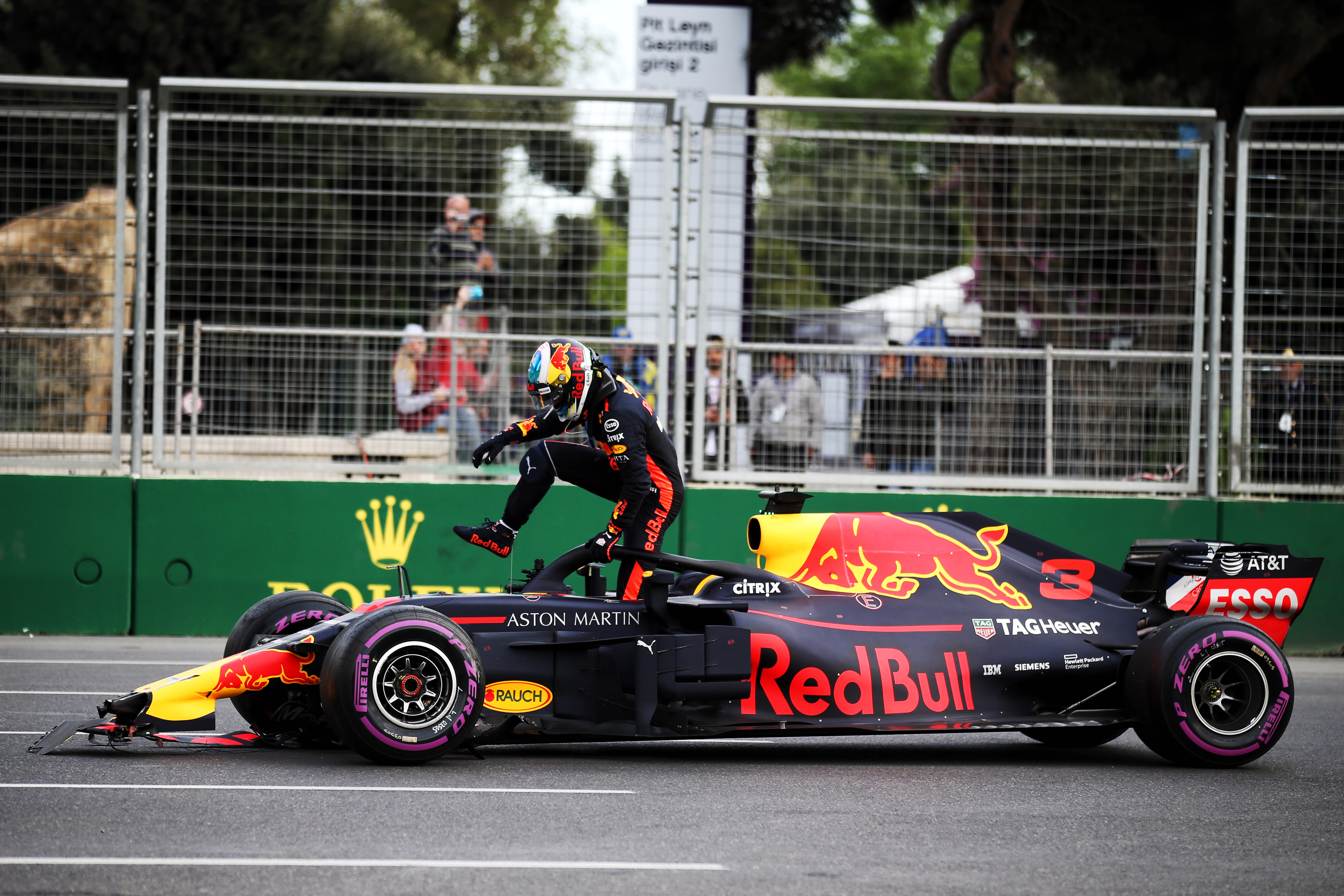
The battle between Red Bull team-mates Daniel Ricciardo and Verstappen had already been frenetic in the first stint of the Azerbaijan Grand Prix, with the duo swapping positions several times as they battled for fourth place. They had already come to grief once, with Verstappen’s right-front making contact with Ricciardo’s left-rear after a DRS pass into Turn 1, but got away with it.
It seemed the battle was resolved in Verstappen’s favour as he managed to emerge from the pits ahead despite stopping a lap later than his team-mate. But with the DRS potent on the streets of Baku, Ricicardo was able to come back at him.
With a big speed advantage, Ricciardo closed on the long run down to Turn 1. Initially, Verstappen occupied the left side of the track to protect the inside line, then jinked to the right to cover Ricciardo, then went back left when the Australian dived the other way.
The pivotal moment in Baku 💥
Ricciardo and Verstappen collide in dramatic fashion
Recording a second double-DNF for Red Bull in three races#AzerbaijanGP 🇦🇿 #F1 pic.twitter.com/OMwH9Ct9BV
— Formula 1 (@F1) April 29, 2018
Ricciardo locked up and hit the back of the sister machine. Both were out on the spot.
While it didn’t cost much in the big picture, Red Bull pointed the finger at both drivers for what happened – Verstappen for moving twice on the straight, Ricciardo as the car that rear-ended him – and there were two significant factors at play.
Firstly, this was during a spate of blunders from Verstappen, which had cost him a victory in China and later a possible Monaco success, that proved to be a positive turning point in his career.
Secondly, while Ricciardo denied being in the same team with Verstappen played a part in his decision to move to Renault in a deal signed later that year, it was clearly among the factors.
– Edd Straw
Best: First podium – Monaco 2006
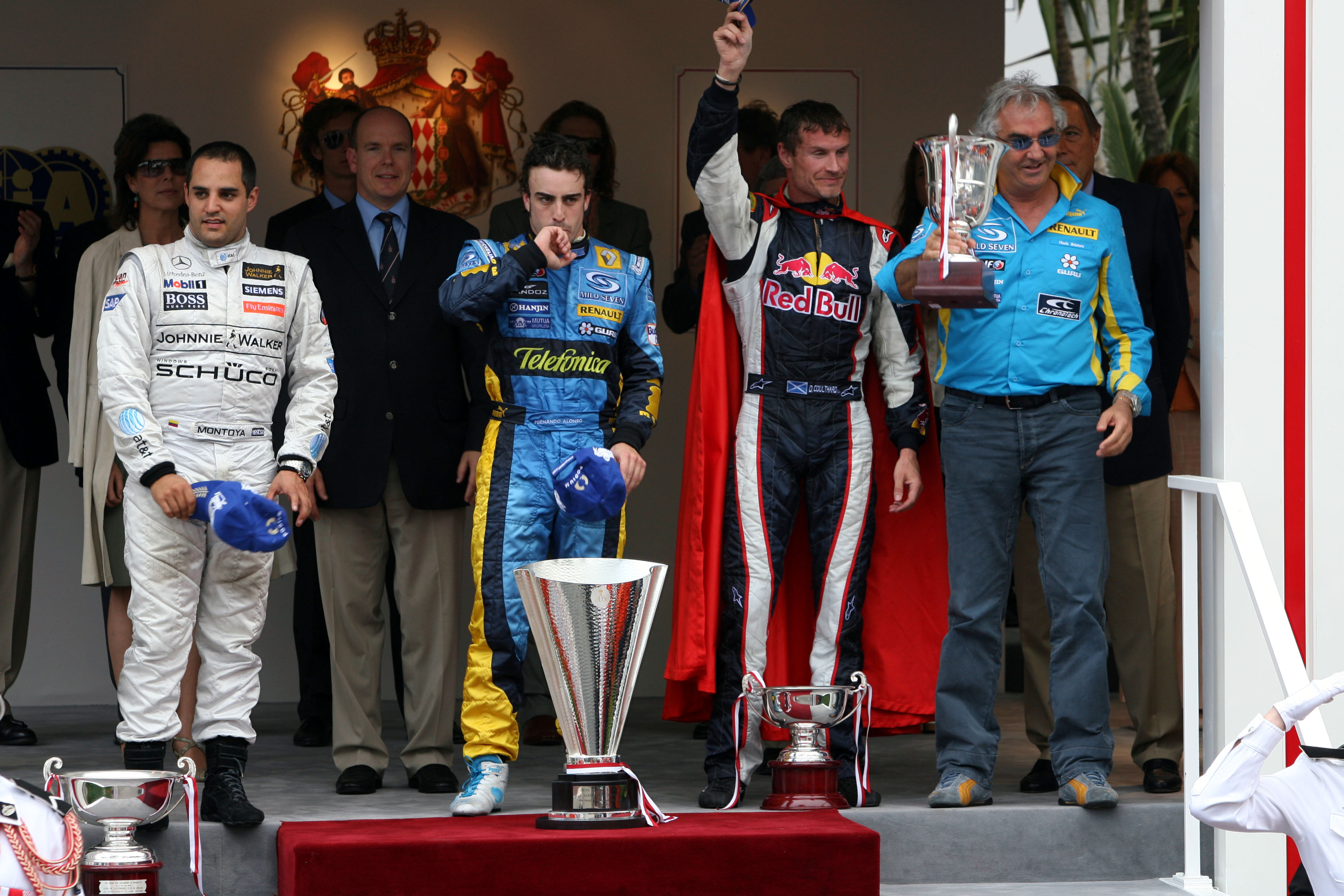
It seems incredible now to suggest Ferrari would help Red Bull to a podium, but rewind to Red Bull’s second F1 season in 2006 and the Prancing Horse propelled Coulthard and the energetic taurus to its first major milestone.
Red Bull had a good start to life in F1 in 2005 with seventh in the constructors’ championship and scored more points in its first year than previous identity Jaguar had managed in the previous two. A switch from Cosworth to Ferrari power signalled an opportunity for further improvement in 2006.
In Monaco, qualifying was overshadowed by Michael Schumacher’s infamous lock-up at Rascasse which cost Fernando Alonso any chance of beating him. Schumacher was penalised – condemned to a pitlane start – and a major frontrunner was eliminated from the reckoning.
In the race, Coulthard pitted on lap 29 of 78 in a normal window for a two-stopper. He was in his box for what seemed like an age. It was a time of refuelling in F1 and the squad – covered from head to toe and wheel to wheel in Superman sponsorship this weekend – was executing a one-stop strategy.
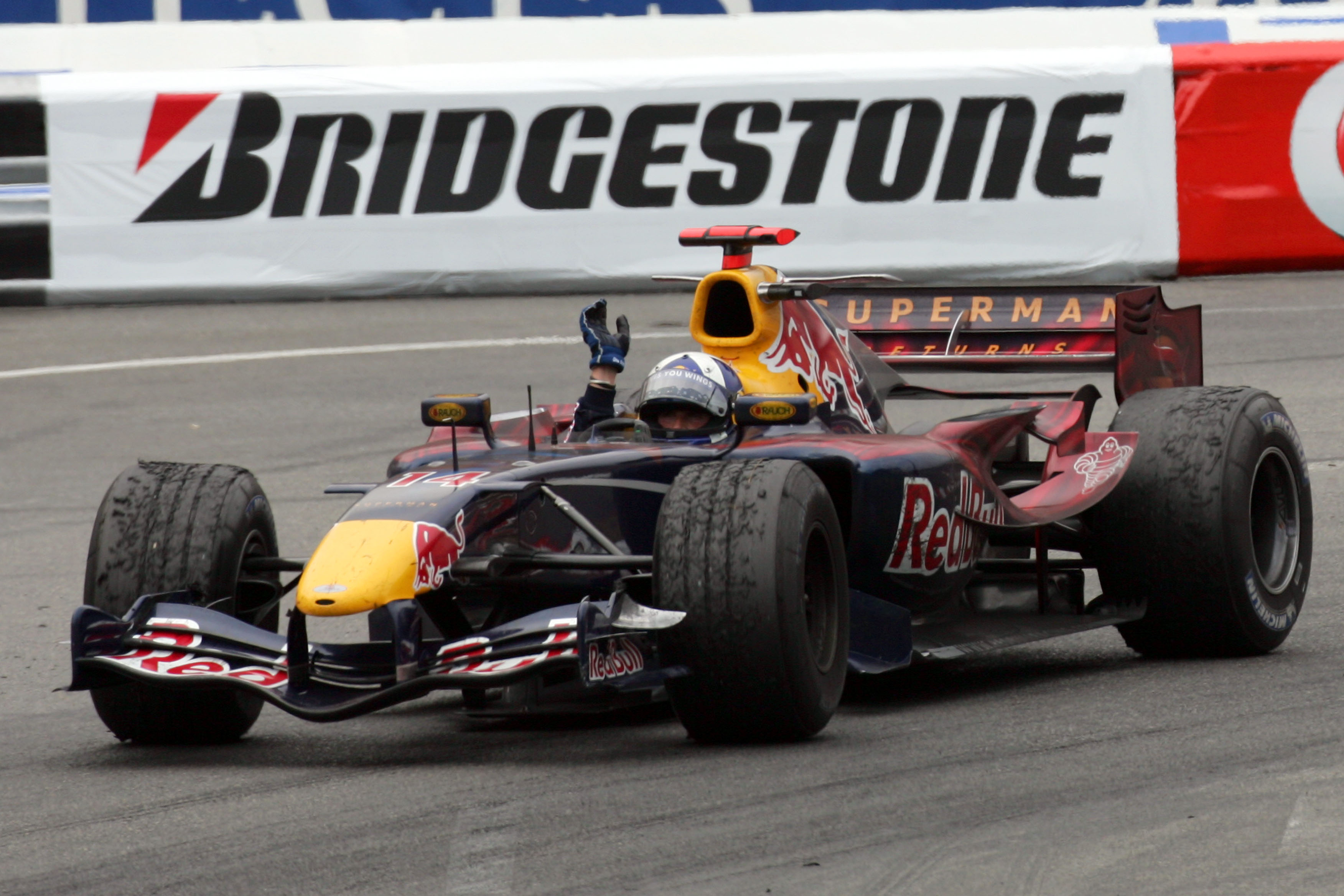
The kryptonite for its rivals in this race was reliability! Alonso (Renault), Kimi Raikkonen’s McLaren and future Red Bull ace Webber (Williams) broke away at the front. But an exhaust fault allowed hot engine gas to destroy the wiring on Webber’s car just over halfway through.
Under the resulting safety car Raikkonen’s hopes went up in smoke and were extinguished (by a marshal). Coulthard’s team-mate Klien – just ahead at that stage – retired shortly after Raikkonen, and Jarno Trulli’s Toyota was next as it suffered a hydraulic failure while running in third.
It's a bird… It's a plane… It's S̶u̶p̶e̶r̶m̶a̶n̶ Christian Horner! 👊@redbullracing celebrated their first #F1 podium #OnThisDay in 2006, in Monaco! pic.twitter.com/tnppT0MPf9
— Formula 1 (@F1) May 28, 2020
All of this allowed Raikkonen’s McLaren team-mate Juan Pablo Montoya and Coulthard to round out the podium, wearing a Superman cape, in dramatic fashion on a day where reaching the end regardless of position was quite an achievement.
Red Bull boss Horner’s reaction was even more exciting – to don the cape, and nothing else, and jump into the famous swimming pool.
– Jack Benyon
Best: Vettel qualifying masterclass – 2011
Not so much one particular moment, but a collection of them. F1 was only in its second year of returning to the battle for pole position being fought out on super-low fuel loads in 2011, and the combination of Vettel and the potent ‘blown diffuser’ RB7 was a joy to watch at the end of Q3 on any given Saturday.
Not familiar with the Istanbul Park track?
Let Sebastian Vettel be your tour guide 😃🚀#TurkishGP 🇹🇷 #F1 pic.twitter.com/f7qyic8eIe
— Formula 1 (@F1) November 7, 2020
Search for any of Vettel’s pole laps from that year and prepare yourself to be truly blown away. He took supreme confidence from what that year’s Red Bull was capable of over a single lap, but it’s not like he drove it on rails.
Some of the laps felt like a collection of near-accidents constantly being gathered up just in time before disaster struck. A true example of man and machine on the absolute limit of adhesion. No wonder he took 15 poles from 19 races that year.
– Glenn Freeman
Worst: Renault downfall – Australia 2015
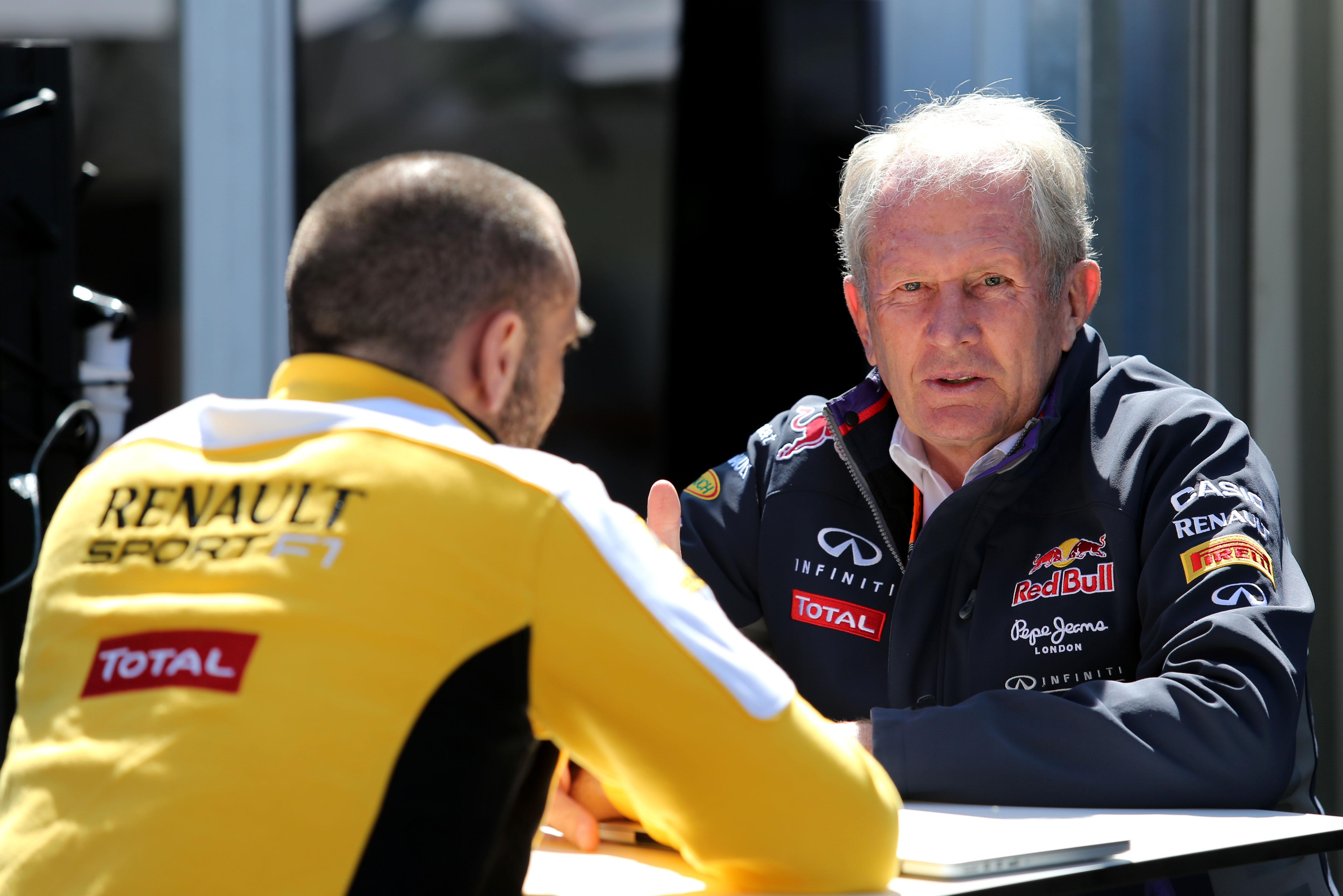
Tracing the point the Red Bull-Renault relationship deteriorated beyond repair is a difficult exercise because there were so many moments that led to cracks appearing.
The difficult first year of the V6 turbo-hybrid rules was bad but Ricciardo still managed to win three races. Sure, four-time world champion and prodigal son Vettel had sought pastures new at Ferrari, but Red Bull and Renault were boisterous about their 2015 prospects without him.
Despite Mercedes’ strength in 2014 and the rise of customer team Williams, Red Bull had still managed to finish second in the constructors’ championship and Ricciardo a fine third in the drivers’ contest in his first Red Bull season.
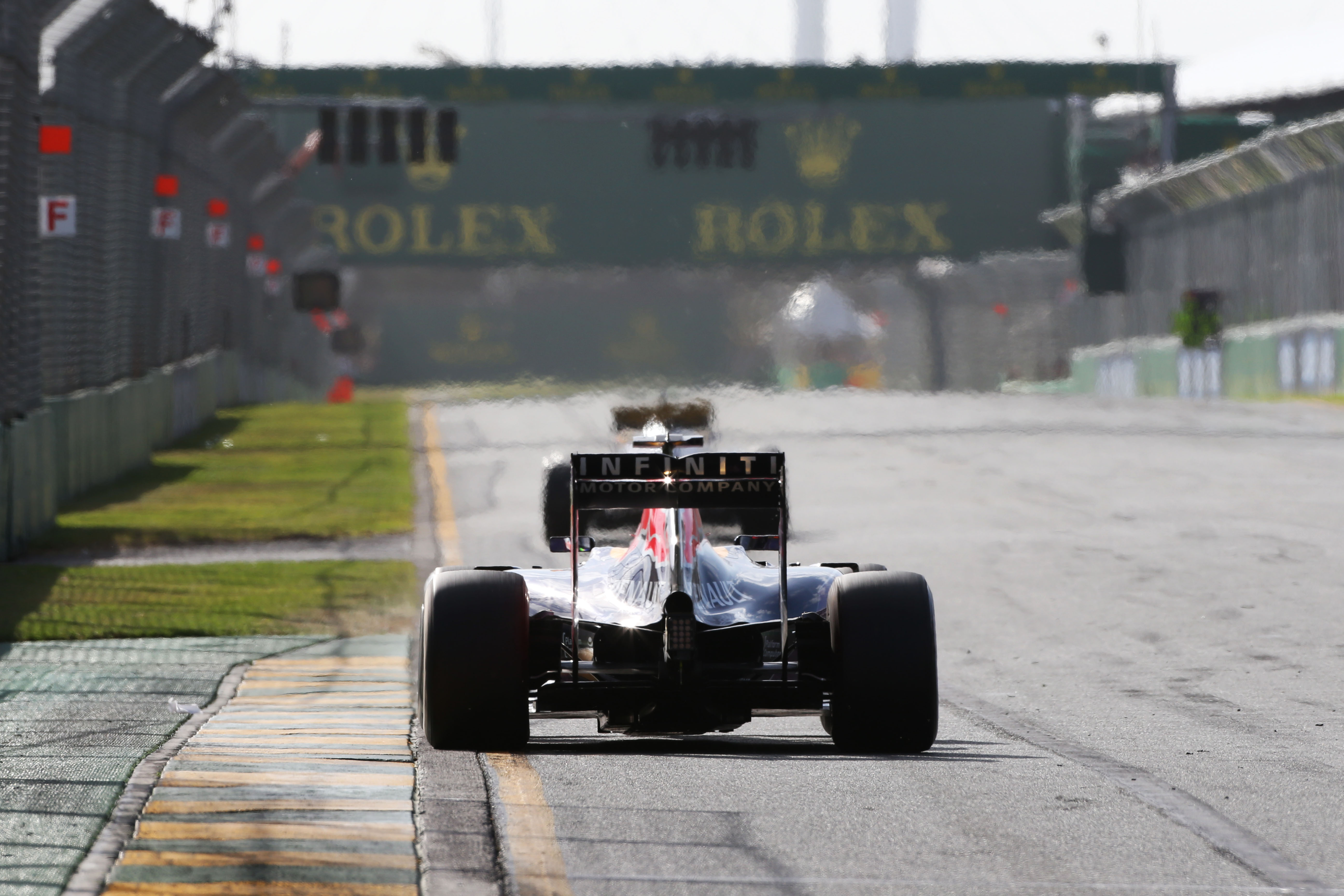
Unfortunately, they took a colossal backwards step. Colossal.
At the end of 2015, Red Bull had fallen behind Williams and Ferrari, and drivers Daniil Kvyat and Ricciardo were seventh and eighth in the championship respectively. It wasn’t that the Renault engine was hopelessly reliable, it’s that the package was so often incredibly uncompetitive.
At the season opener in Australia though, it was both. Kvyat failed to make the start. Ricciardo was a lapped sixth. Melbourne kicked off Red Bull’s worst season since becoming a race winner in 2009 as it sunk to a depth it hasn’t come close to since. That season still stands as Red Bull’s only winless year in more than a decade.
It’s hard not to think this was the beginning of the end of the partnership, the first step in a long, painful divorce from Renault, too.
– Scott Mitchell
Best: Vettel’s comeback – Brazil 2012
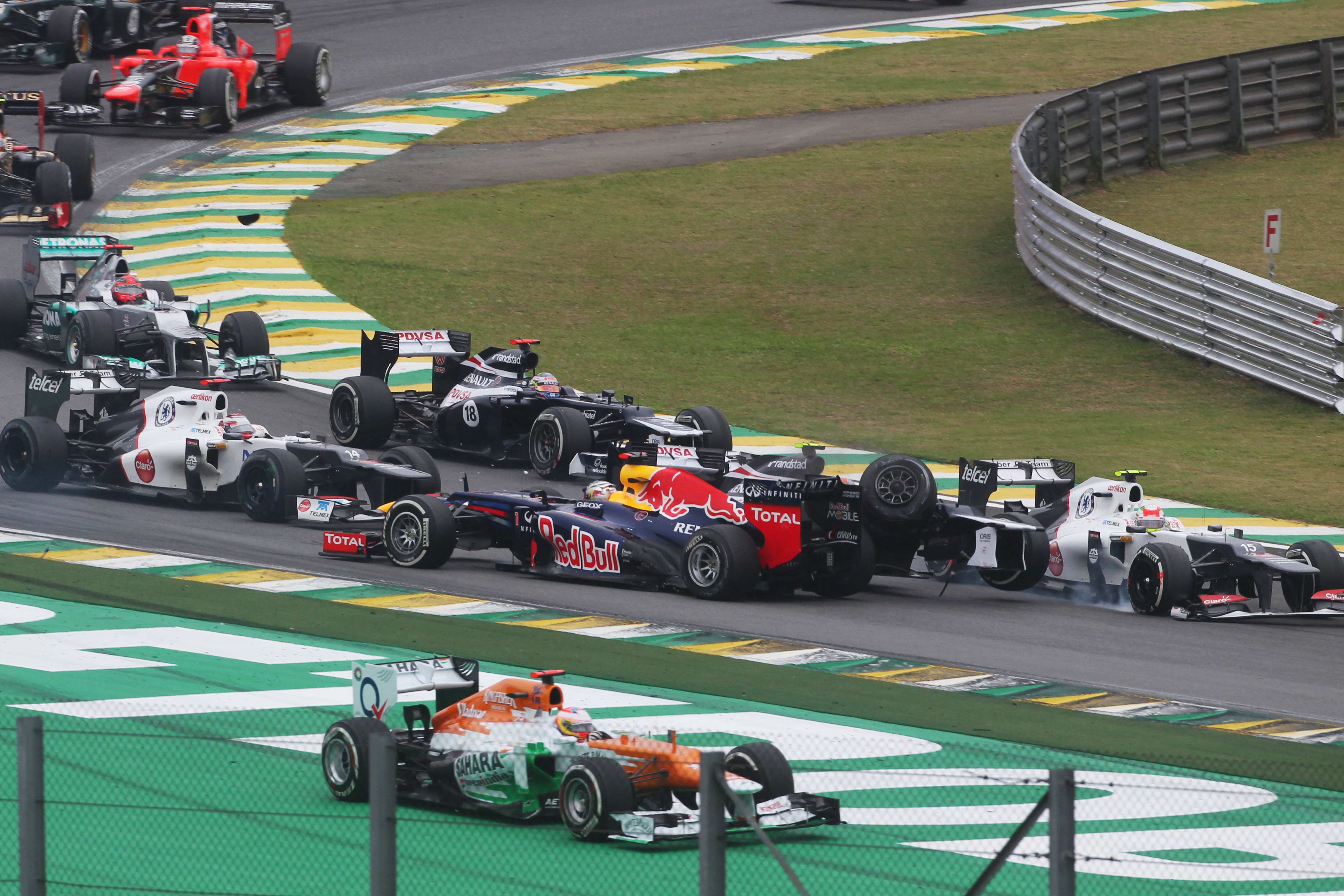
A 39-point deficit became a 13-point advantage over Ferrari’s underdog hero Alonso in the 2012 title race after Vettel finally tickled the sweet spot of his tetchy Red Bull RB8, and he swept to a four race winning streak at Singapore-Suzuka-Korea and the Buddh Circuit in India.
By the time the familiar cauldron-like atmosphere had built at Interlagos for the final race Vettel was odds on for a third consecutive title, that was until he rounded the Descida do Lago left hander backwards with a chunk missing from his left-hand sidepod.
The incident itself was classic first lap midfield mayhem, but an overly cautious Vettel had put himself there with an insipid first few corners.
After rejoining, Vettel also soon realised he had another issue – no car to pit radio. It was working the other way from his crew to him, and perhaps it was just as well.
Highlights from one of the most unforgettable season showdowns in living memory – Brazil 2012!
Presented by @pirellisport #F1Rewind ⏪ #F1 pic.twitter.com/CnHmdaLv7J
— Formula 1 (@F1) April 25, 2020
At least Vettel could hear his engineer Guillaume Rocquelin telling him to change engine mapping settings to reduce the exhaust temperatures to try to avert the threat of his bodywork igniting.
If a title ever appeared to dangle by a thread, it was right now.
As if that were not drama enough, bands of light drizzle sprinkled the Interlagos neighbourhood and as such Vettel boiled up to the point of his brilliant best.
Scything through the field in ever-changing conditions, he went from 22nd to fourth by lap 18!
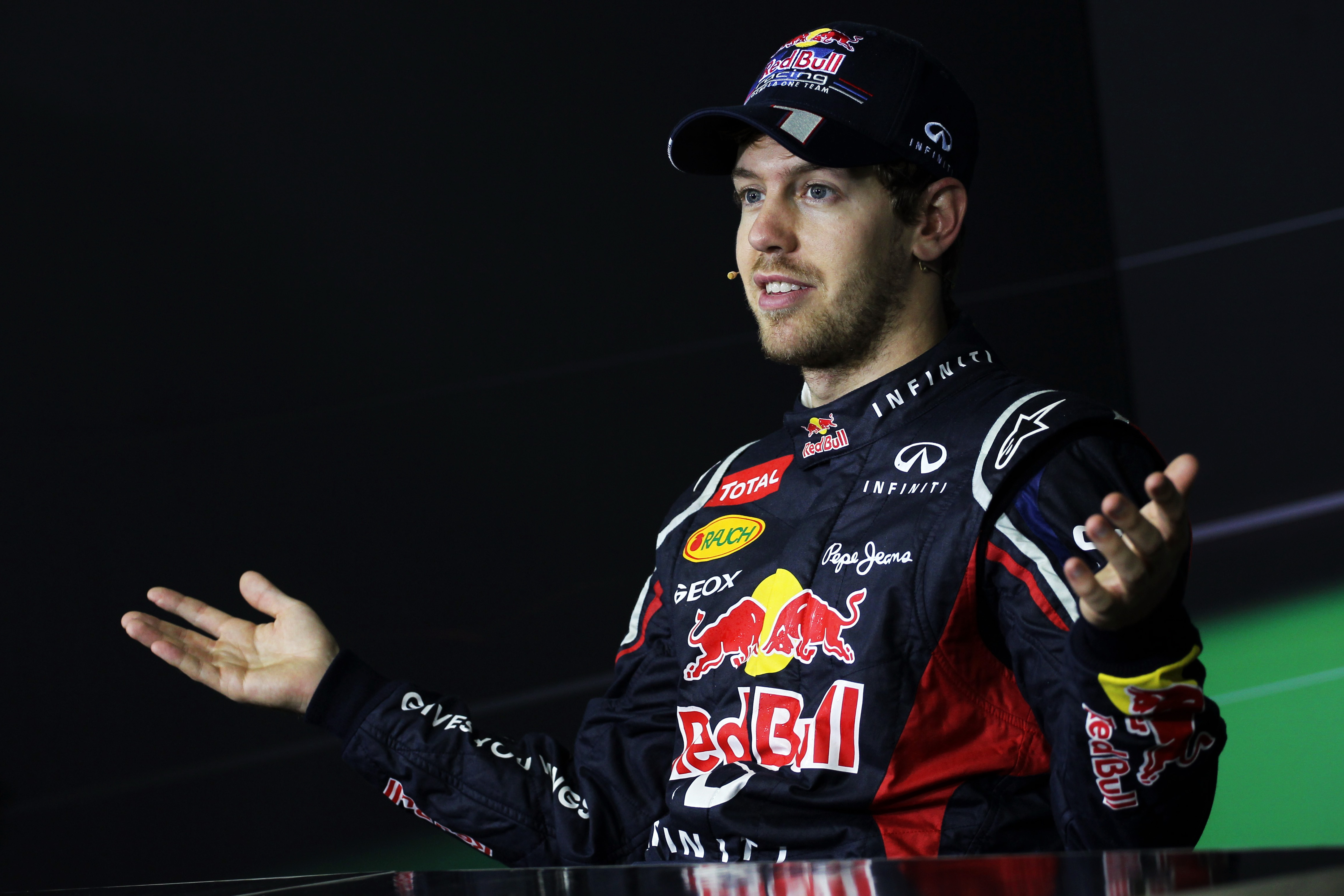
The radio issues returned to haunt in the closing stages as Vettel ducked in for a set of inters unbeknown to the team, and the lengthy pitstop gave title rival Alonso brief hope.
But Vettel smoothed out the drama by taking a carefully managed sixth place to Alonso’s second, somewhat anti-climactically sealing the deal behind the safety car which came out for a third time that afternoon to clear away Paul di Resta’s shunted Force India.
The feverish Paulistas in the grandstands stood and saluted Vettel’s drive because 21 years prior they had watched in awe their beloved Ayrton Senna drive a similar race in a crocked car and changeable conditions under pressure.
– Sam Smith
Best: The first title – Abu Dhabi 2010
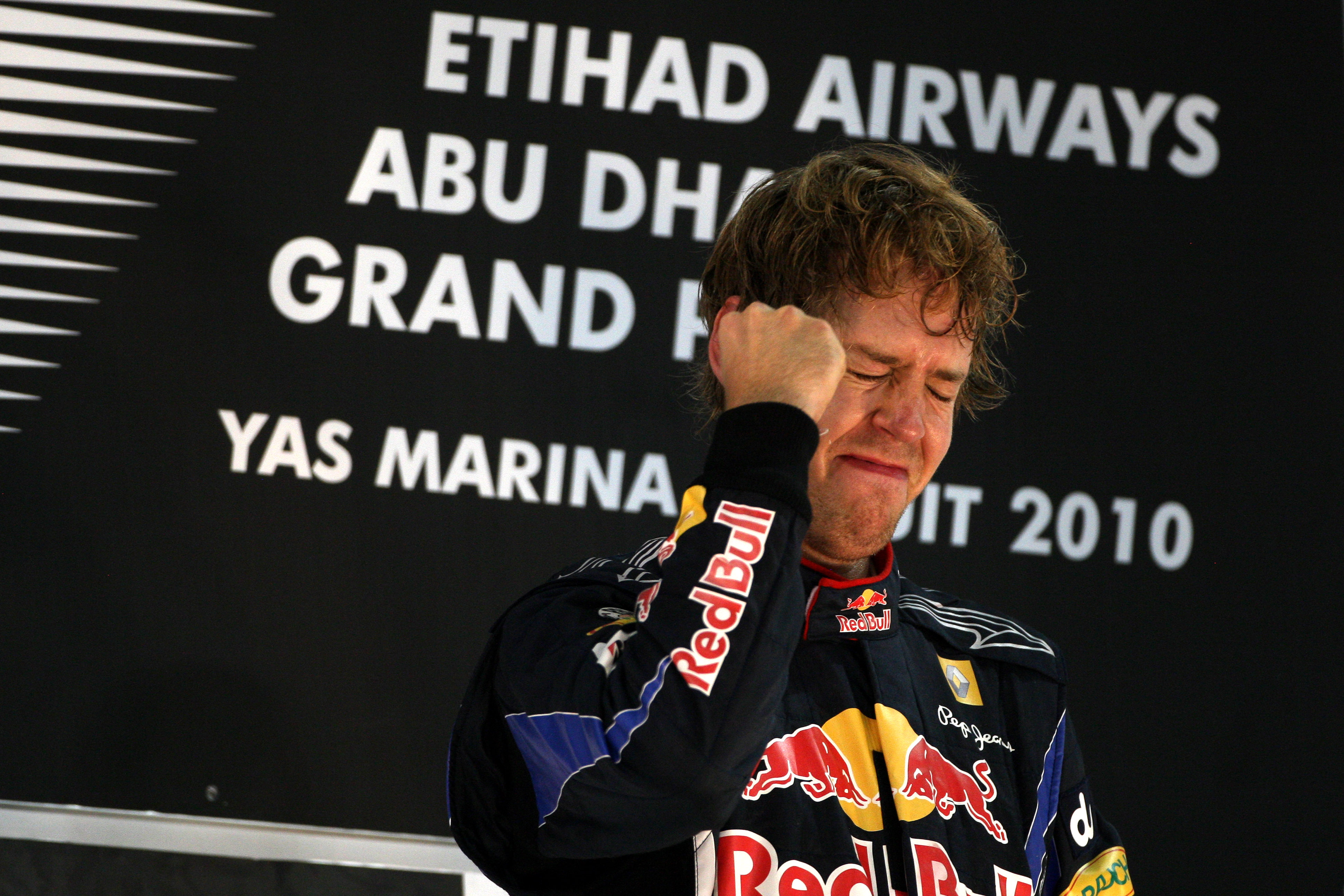
Red Bull had already broken its title duck by clinching the constructors’ championship with a 1-2 finish in the Brazilian Grand Prix. But it’s always the season finale in Abu Dhabi, where Vettel clinched an unexpected drivers’ title that sticks in the mind – primarily because of the euphoria in the paddock behind the Red Bull garage after the race.
It was the most extraordinary of finales. The growing tension between the Red Bull drivers and team, with Webber’s accusations that it favoured Vettel in Brazil and, after the race at Interlagos, suggesting team orders should have been used to help his title fight with Alonso.
Heading into the Abu Dhabi Grand Prix, the championship battle was really Alonso vs Webber, with six points separating the pair. Vettel was an outsider, given he was 15 points behind Alonso – with Lewis Hamilton also just in contention but needing victory with disasters befalling his rivals to nick the crown. But things changed early in the race.
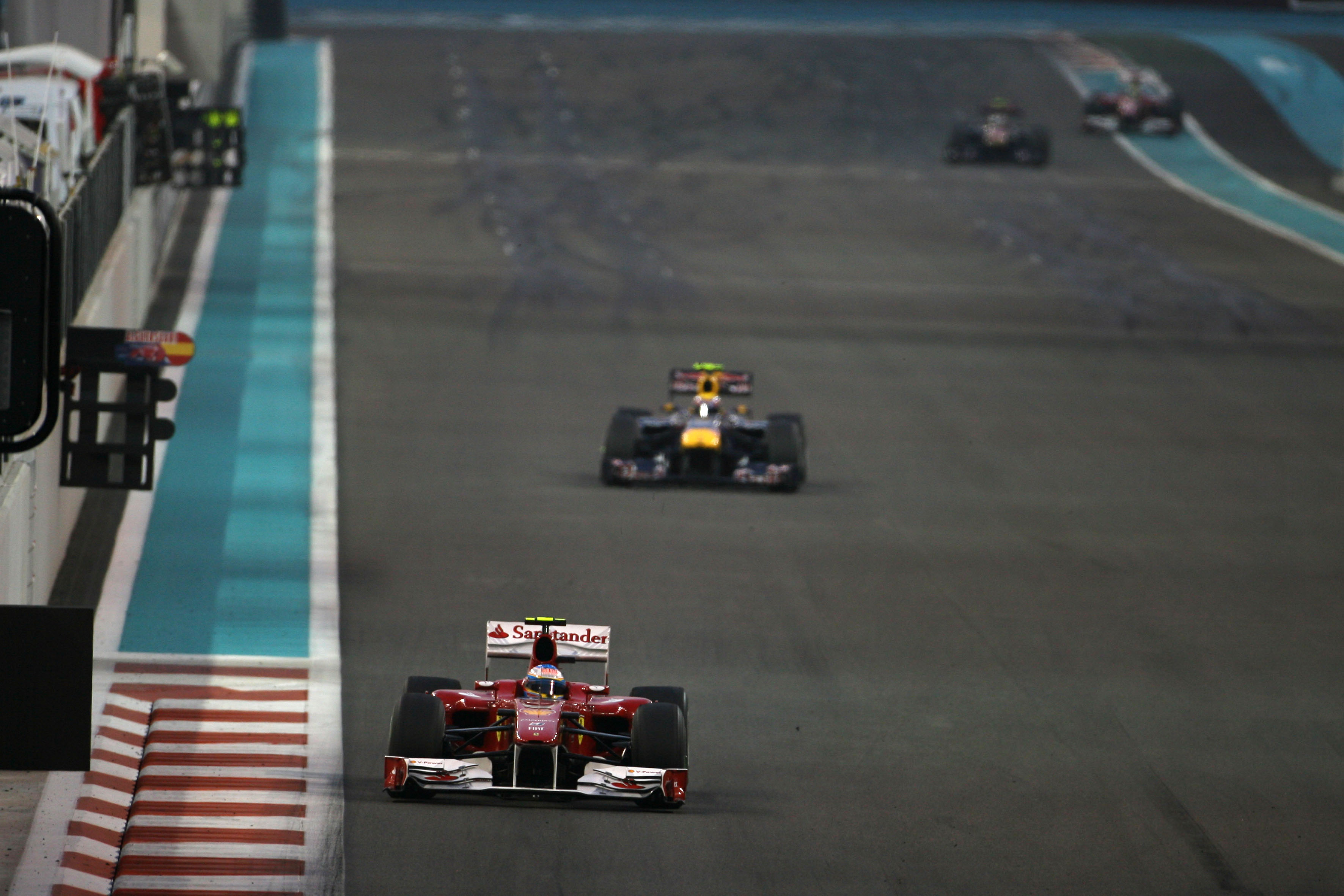
Vettel comfortably led from pole position with Alonso running third and Webber fifth. Advantage Alonso. But Webber was struggling and, having earlier grazed the wall, he opted for an early pitstop after 11 laps. Four laps later, Alonso was brought in to cover Webber, emerging ahead and achieving that objective.
But it was a Pyrrhic victory for Ferrari, which was both too fixated on Webber and had failed to realise that a laptime-sapping graining phase with the tyres that Alonso went through just before the stop would clear.
As a result, Alonso spent the rest of the race staring at Vitaly Petrov’s rear wing after the Renault driver had stopped on lap one, with Webber behind both.
Emotional scenes in Abu Dhabi back in 2010 as Seb becomes the F1 world champion for the first time ☝️🏆🎆#F1 pic.twitter.com/T7KHOsvRFq
— Formula 1 (@F1) November 14, 2018
Vettel, meanwhile, cruised to a dominant victory to become Formula 1’s youngest world champion. Cue jubilance at Red Bull.
On a day when Webber, never a big fan of the modern circuits and at his best at tracks that left less margin for error, struggled, the irony was that his early pitstop had led Ferrari astray and left Vettel with an open goal.
It was the first, and most memorable, of Red Bull’s four consecutive title doubles.
– Edd Straw
Worst: A crashing farewell – Brazil 2008
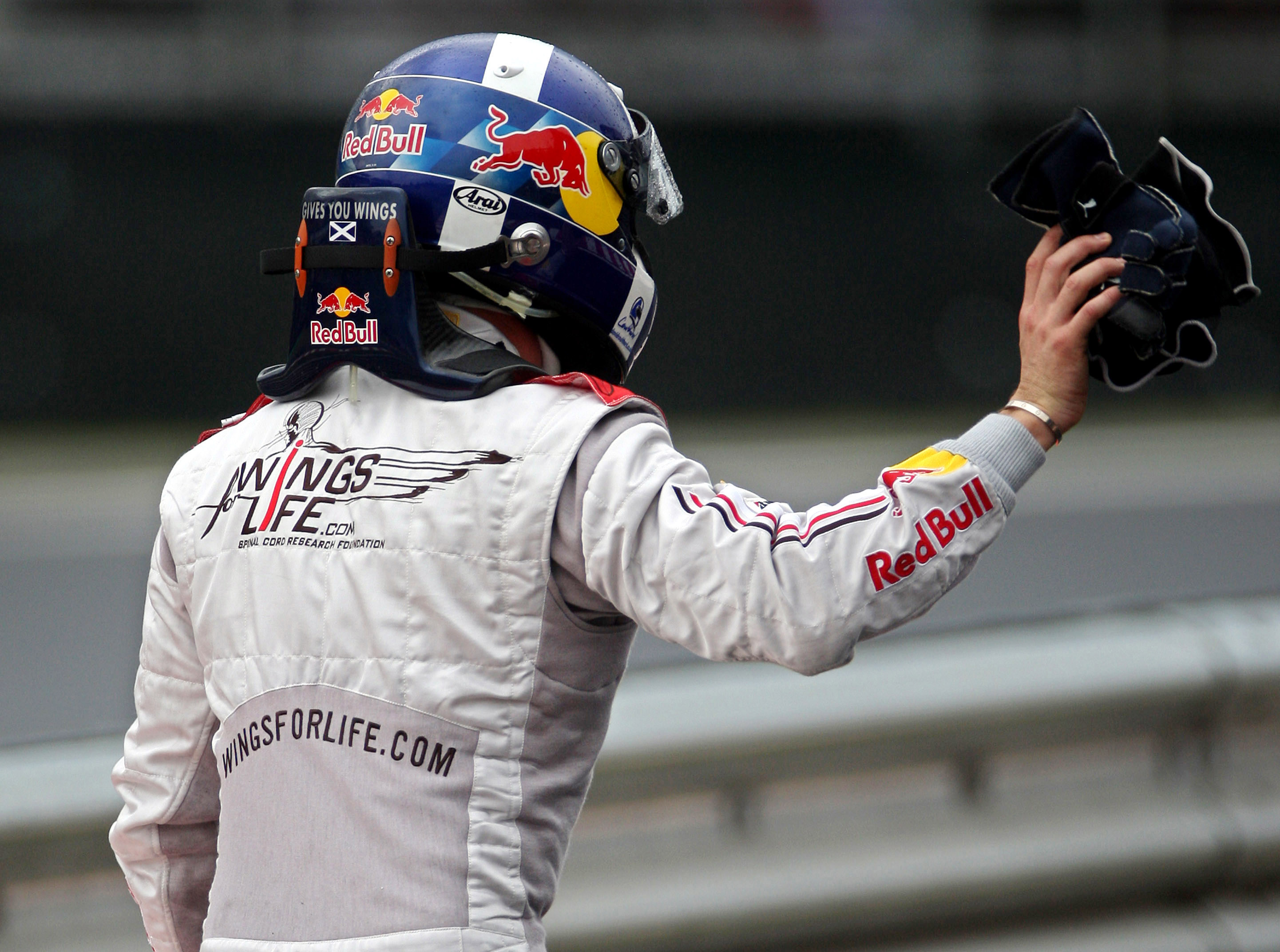
It so rarely happens the way scriptwriters intend for a retiring driver. It should be a final glorious grand prix ending on the podium to sign off a long an illustrious career.
Glittering valedictories are rare. More often than not it’s a Jody Scheckter style ignominious 11th at Watkins Glen – or a Nigel Mansell type fade away – rather than a Keke Rosberg in Adelaide in 1986, exiting from the lead.
Coulthard had built up all the goodwill and stereotypical last hurrah momentum he could muster. He had a special helmet made for the occasion, and the paddock revelled in nostalgia stretching all the way back to his early days when he had the unenviable task of replacing Ayrton Senna at Williams mid-1994.
No one expected Coulthard to be waving a Saltire from the top step of the podium. But ending his final race wedged forlornly on a kerb at the first corner and being forced to trudge back to the pits as the TV cameras largely focused on a brewing title battle was just plain cruel.

The last quarter of a mile of his career began from an anonymous 14th place for Coulthard, capping off a woeful season for Red Bull.
DC’s third place in Canada was its only podium finish that year, and RBR lagged behind sister team Toro Rosso (powered by Ferrari) by 10 points in the final constructors’ standings. An inherent traction shortfall in slow-speed corners and a mediocre Renault V8 contributed to the team’s struggles.
Still, retiring seconds after leaving the grid for the final time with deranged suspension after a pincer movement by Williams duo Nico Rosberg and Kazuki Nakajima was still a tough pill to swallow.
At 37, the writing had long since been on the wall for Coulthard, and he knew it.
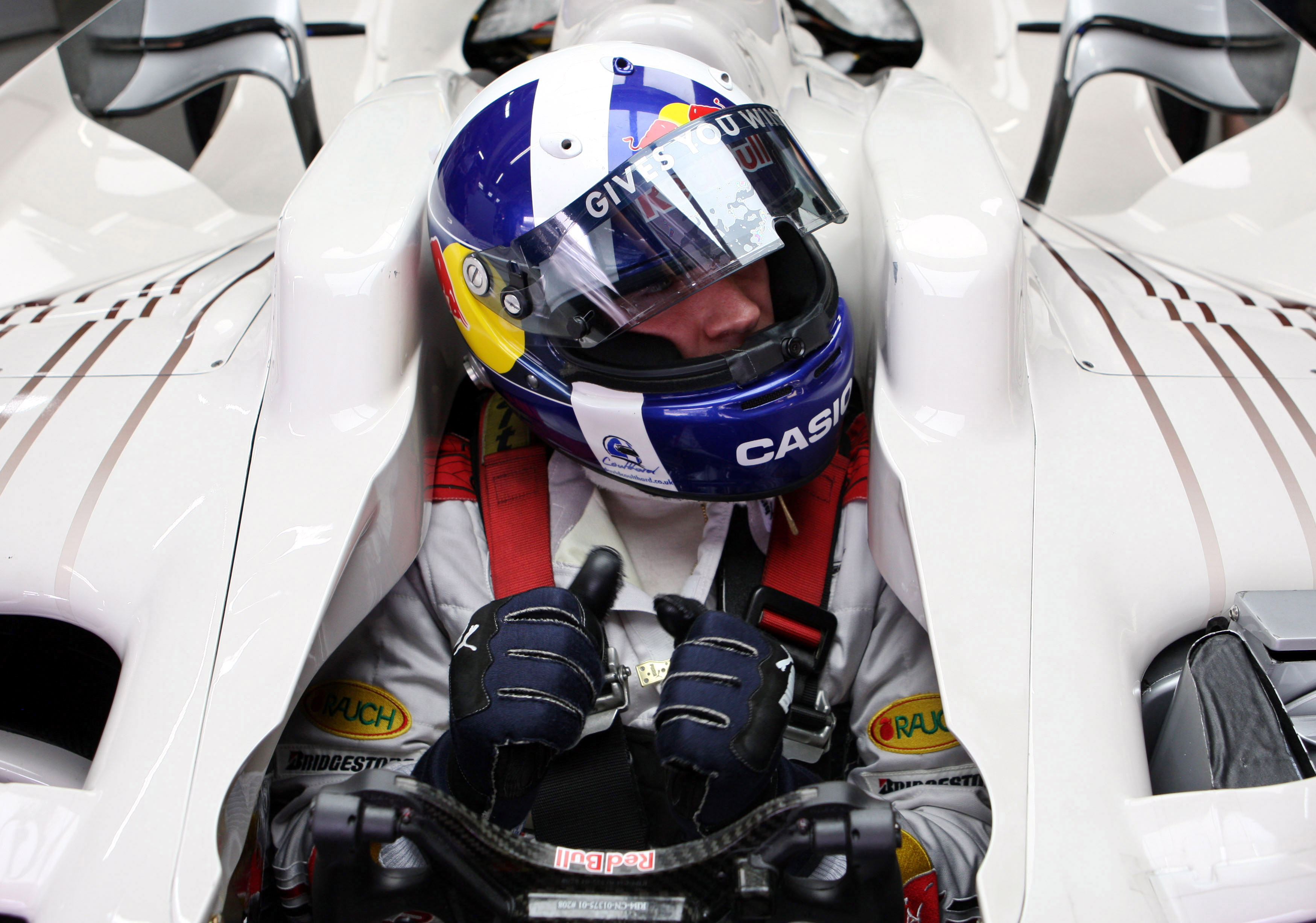
“I’m not that ego driven to refuse to acknowledge when the time has come to stop,” he told Maurice Hamilton as he walked away from his competitive career.
“I had passed my best in terms of my potential in F1. Therefore I decided to stop racing in F1. If I hadn’t done that , the team would probably have come to me and said you are no longer required…
“So, whatever way you want to see it, I preferred to be driving the process and developing a relationship with Red Bull to continue, whilst the relationship is still there.”
Ever the pragmatist, Coulthard’s disappointment that day at Interlagos was quickly swept away by knowing that he and his career would have the affection and respect of the paddock and millions of fans forever.
– Sam Smith
Best: Verstappen’s debut – Spain 2016
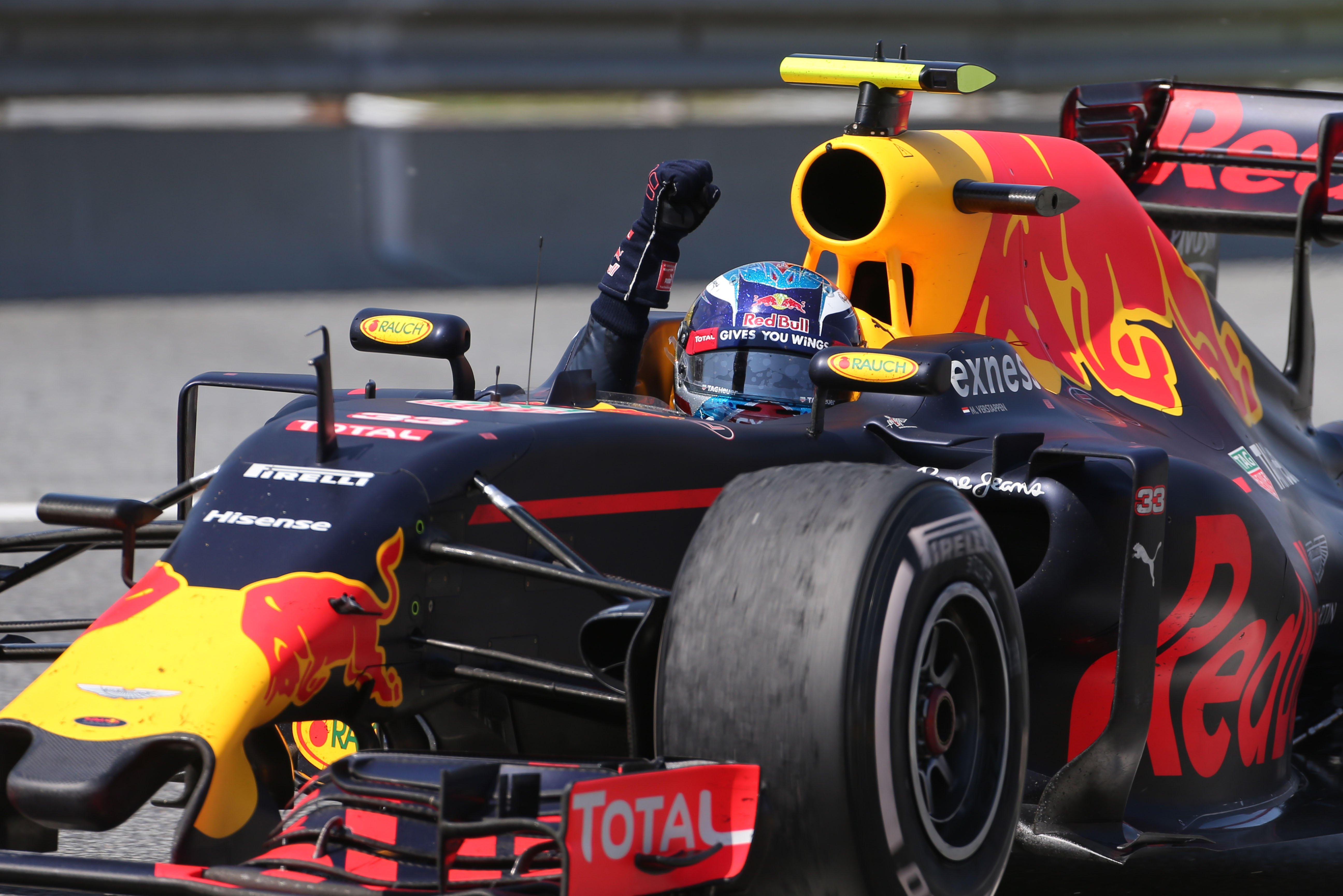
On promoting Verstappen to Formula 1 at the age of 17, Red Bull had its doubters. Even the FIA moved to implement superlicence rules to restrict drivers so young entering again in the future.
Despite the questions raised by fans, media and some in the paddock, Verstappen was an instant hit at Toro Rosso. Even so, not even a crystal ball could have predicted the now 18-year-old – 24 races into his Formula 1 career – replacing Kvyat in the top team for the Spanish Grand Prix in 2016.
Kvyat said his demotion to Toro Rosso was “a bit of a shock” and that he “will try to give as loud an answer as possible on the track”.
Verstappen shook off the questions of risk in the move Red Bull had made and qualified fourth in his initial outing, albeit four tenths off team-mate Ricciardo.
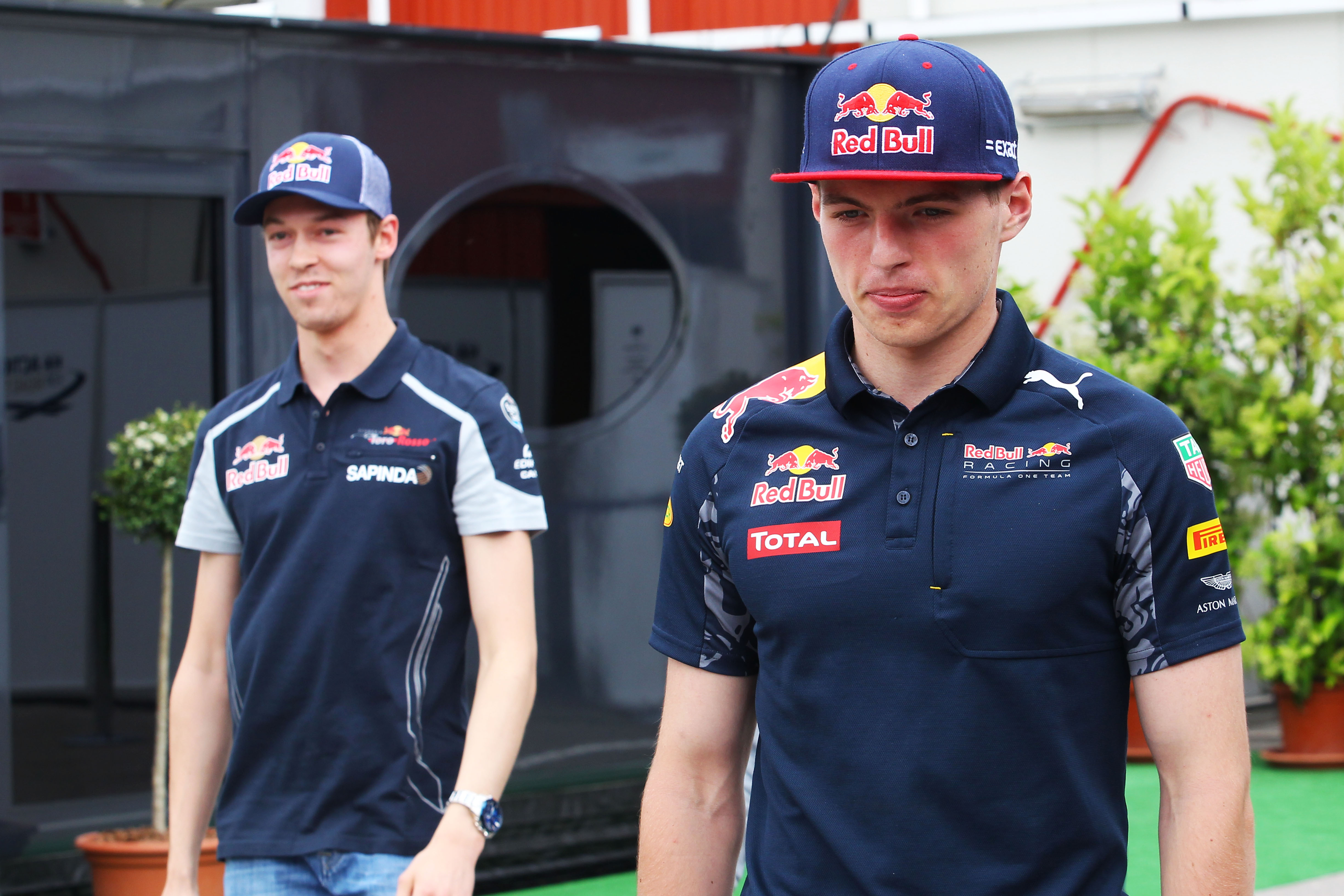
In the race, the two Mercedes crashed into each other at Turn 4 as Nico Rosberg shut the door on Hamilton and Hamilton’s trip through the grass collected both cars.
While that was happening, Verstappen did well to hold off Vettel by maintaining position around the outside of Turn 3.
Ricciardo inherited the lead but it would soon become a race of strategy. He and Vettel elected to three-stop, with Vettel jumping Ricciardo in the pitlane exchanges. Ricciardo tried a brave wheel-banging move at Turn 1 later on, to which Vettel accused Ricciardo of playing ping pong as opposed to racing.
Ultimately it didn’t matter in the results as Ricciardo scored a rear-left puncture ruling him out of the equation.
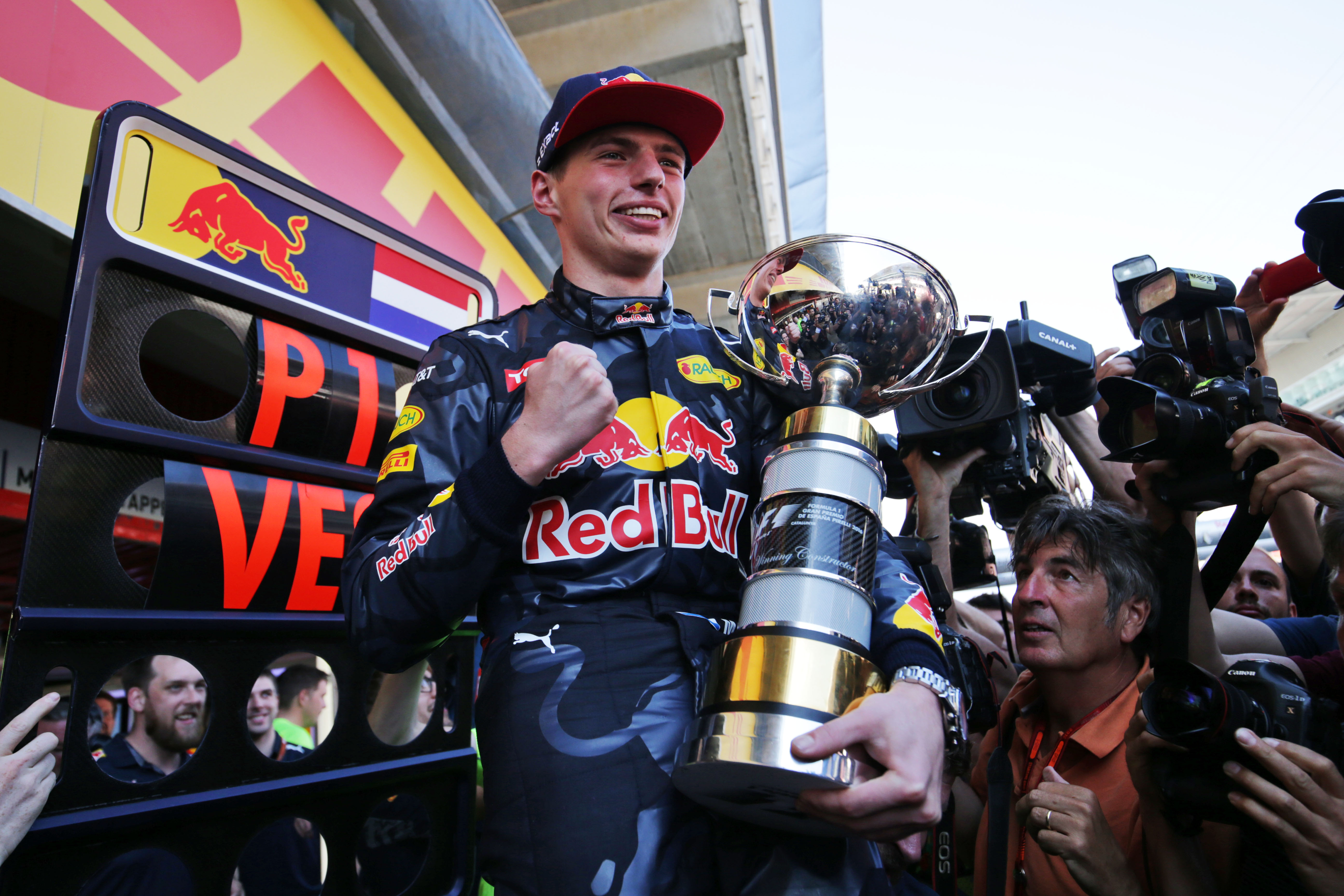
Verstappen was harried by the second Ferrari of Raikkonen – also two-stopping like Verstappen – but even the experienced Finn couldn’t coax the young bull into an error despite race-long pressure.
They crossed the line astern, with Verstappen giving Red Bull an immediate reprieve from the criticism it had received. One of the few shock race wins of recent years.
– Jack Benyon


